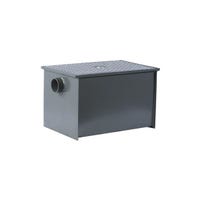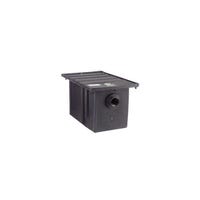Grease Traps
-
 Dormont WD-50-L Grease Interceptor/Trap 50 GPM 100 lb CapacityFree ShippingBurkett Price: $1,640.99 / Each
Dormont WD-50-L Grease Interceptor/Trap 50 GPM 100 lb CapacityFree ShippingBurkett Price: $1,640.99 / Each -
 Dormont WD-35-L Grease Interceptor/Trap 35 GPM 70 lb CapacityFree ShippingBurkett Price: $1,503.99 / Each
Dormont WD-35-L Grease Interceptor/Trap 35 GPM 70 lb CapacityFree ShippingBurkett Price: $1,503.99 / Each -
 Dormont WD-50 Grease Interceptor/Trap 50 GPM 100 lb CapacityFree ShippingBurkett Price: $1,170.99 / Each
Dormont WD-50 Grease Interceptor/Trap 50 GPM 100 lb CapacityFree ShippingBurkett Price: $1,170.99 / Each -
 Dormont WD-35 Grease Interceptor/Trap 35 GPM 70 lb CapacityFree ShippingBurkett Price: $958.99 / Each
Dormont WD-35 Grease Interceptor/Trap 35 GPM 70 lb CapacityFree ShippingBurkett Price: $958.99 / Each -
 Dormont WD-20-L Grease Interceptor/Trap 20 GPM 40 lb CapacityFree ShippingBurkett Price: $913.99 / Each
Dormont WD-20-L Grease Interceptor/Trap 20 GPM 40 lb CapacityFree ShippingBurkett Price: $913.99 / Each -
 Dormont WD-25 Grease Interceptor/Trap 25 GPM 50 lb CapacityFree ShippingBurkett Price: $736.99 / Each
Dormont WD-25 Grease Interceptor/Trap 25 GPM 50 lb CapacityFree ShippingBurkett Price: $736.99 / Each -
 Dormont WD-20 Grease Interceptor/Trap 20 GPM 40 lb CapacityFree ShippingBurkett Price: $558.99 / Each
Dormont WD-20 Grease Interceptor/Trap 20 GPM 40 lb CapacityFree ShippingBurkett Price: $558.99 / Each -
 Dormont WD-15 Grease Interceptor/Trap 15 GPM 30 lb CapacityFree ShippingBurkett Price: $458.99 / Each
Dormont WD-15 Grease Interceptor/Trap 15 GPM 30 lb CapacityFree ShippingBurkett Price: $458.99 / Each -
 Dormont WD-10 Grease Interceptor/Trap 10 GPM 20 lb CapacityFree ShippingBurkett Price: $395.99 / Each
Dormont WD-10 Grease Interceptor/Trap 10 GPM 20 lb CapacityFree ShippingBurkett Price: $395.99 / Each -
 Dormont WD-7 Grease Interceptor/Trap 7 GPM 14 lb CapacityFree ShippingBurkett Price: $320.99 / Each
Dormont WD-7 Grease Interceptor/Trap 7 GPM 14 lb CapacityFree ShippingBurkett Price: $320.99 / Each -
 Dormont WD-4 Grease Interceptor/Trap 4 GPM 8 lb CapacityFree ShippingBurkett Price: $282.99 / Each
Dormont WD-4 Grease Interceptor/Trap 4 GPM 8 lb CapacityFree ShippingBurkett Price: $282.99 / Each
It’s common knowledge that you shouldn’t pour grease down the drain, but when you’re cooking in a fast-paced commercial kitchen, it might seem like the fastest option. Worry not - a grease trap can easily turn this bad practice into a safe one. Grease traps are the ideal solution for keeping fats, oils, and grease from clogging up any drain pipes. They slow the flow of water in the drain, cooling, solidifying, and trapping oils and grease and storing them until you clean them out.
Frequently Asked Questions About Grease Traps
How Often Does a Grease Trap Need to Be Cleaned?
This depends on use, but typically it is good practice to clean your grease trap at least once a month. You should never let any grease trap fill more than 25% for best efficiency. Follow the manufacturer’s instructions for your unit’s specific cleaning requirements.
How Do You Choose a Size for a Grease Trap?
The size you choose will depend on your sink or dishwashers’ highest GPM. After you determine your maximum GPM, you can find a grease trap that is rated for that measurement.
Where Should a Grease Trap Be Installed?
Grease traps should be installed as close as possible to the sink/dishwasher, so that the pipes leading to the trap do not get clogged with grease and oil. They can be installed either in or on the floor, as long as the top can be accessed for cleaning and maintenance. Check how much clearance your unit will require for maintenance before you choose where to install it, as if you place it under a sink it may not have the required clearance.








Login and Registration Form